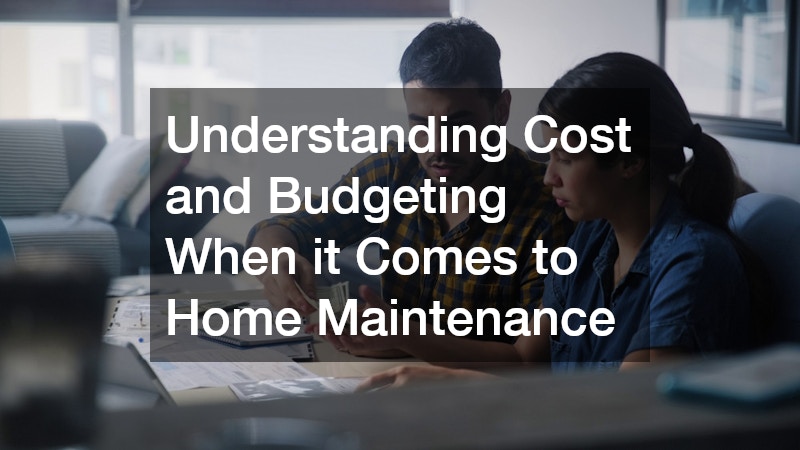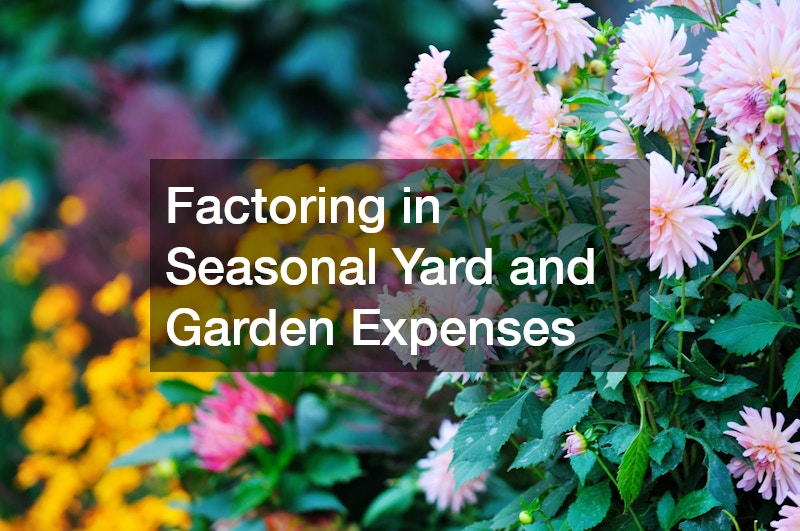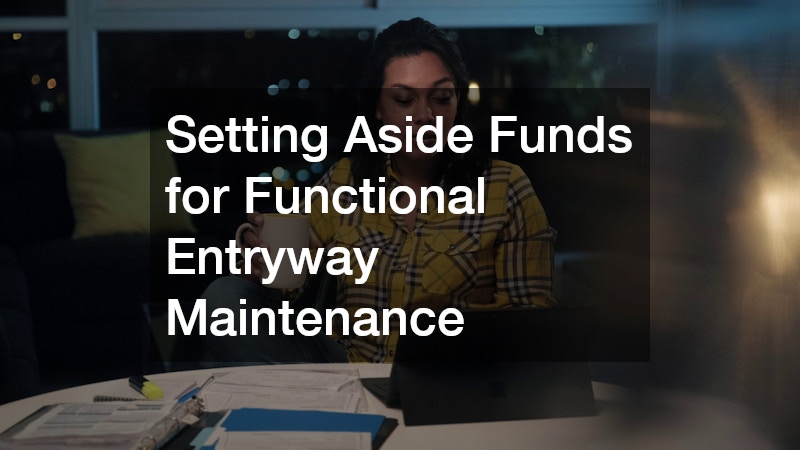Managing a home requires more than just day-to-day upkeep; it involves long-term financial planning to handle both expected and unexpected expenses. From routine services to sudden repairs, every aspect of homeownership carries potential costs that can add up quickly if not accounted for properly. Many homeowners underestimate how much regular maintenance can impact their finances over time, leading to last-minute scrambles or delayed repairs that can end up being more expensive in the long run. By approaching these responsibilities strategically, families can avoid financial stress and keep their properties in good condition.
Understanding cost and budgeting for home maintenance involves taking a proactive approach. Instead of reacting to problems as they arise, it’s wise to create a realistic plan that includes routine upkeep, emergency savings, and larger improvement projects. This helps ensure that when issues occur—whether they’re seasonal or structural—you’re prepared. Prioritizing and planning ahead allows homeowners to maintain both their property’s value and their financial stability.
Factoring in Seasonal Yard and Garden Expenses
Seasonal maintenance often seems minor, but these recurring costs can have a significant impact on household finances. Yard work, garden upkeep, and general landscaping not only improve curb appeal but also prevent more serious issues from developing. If left unmanaged, overgrown plants, invasive weeds, or neglected outdoor spaces can lead to property damage that costs far more to fix later. Factoring these seasonal needs into your overall cost and saving strategy ensures that your outdoor areas remain both attractive and functional year-round.
Weed control is one of those regular expenses that homeowners should anticipate. Whether you handle it yourself with store-bought products or hire professionals, keeping weeds under control prevents damage to lawns, gardens, and walkways. Budgeting for these treatments seasonally—especially during spring and summer when growth is rapid—can help you avoid the higher costs associated with repairing cracked pavement, overrun gardens, or damaged outdoor structures. It’s a relatively small line item that can save substantial money over time.
Accounting for Unexpected Remediation Needs
Not every home maintenance cost can be predicted, and that’s where having a financial buffer becomes essential. Some problems develop slowly over time and go unnoticed until they require immediate attention, while others can arise suddenly due to weather or environmental conditions. These types of remediation needs are often more expensive because they involve health and safety concerns that require professional intervention. Planning ahead for potential emergencies is a key part of effective cost and budgeting for any homeowner.
For example, working with a mold removal company may become necessary if moisture problems are left unchecked. Mold can spread quickly, compromising indoor air quality and damaging walls, flooring, and insulation. Remediation can be costly, particularly if the problem has progressed over time, but addressing it promptly is critical to avoid structural damage and health risks. Setting aside funds for unexpected repairs like this helps homeowners act quickly when issues arise, minimizing both stress and long-term expenses.
Planning for Structural Protection and Upgrades
Some of the most important home maintenance tasks happen out of sight, yet they play a huge role in preserving your property’s integrity. Structural protection often involves preventive measures that keep your home safe from water damage, pests, and shifting soil. These upgrades may not seem urgent, but delaying them can lead to serious problems that are far more expensive to fix later. Including these types of projects in your overall cost and budgeting plan ensures that your home remains stable and protected for years to come.
Crawl space encapsulation is a good example of this kind of investment. By sealing and insulating the crawl space, homeowners can prevent moisture buildup, mold growth, and even pest infestations. This process can also improve indoor air quality and energy efficiency, leading to long-term savings. While the upfront cost may seem significant, it’s far less than the expenses associated with repairing water damage or addressing structural deterioration. Planning ahead for these types of protective upgrades is both financially and practically smart.
Budgeting for Essential Home Utility Services
Every home relies on a network of essential utilities, and maintaining these systems is critical for comfort, safety, and functionality. Plumbing, electrical, and HVAC systems require regular attention to keep everything running smoothly. Unexpected breakdowns in these areas can cause major disruptions and come with high repair costs if not addressed early. Allocating part of your cost and budgeting plan toward routine service and inspections is one of the best ways to prevent emergencies.
Scheduling regular maintenance with a reliable plumbing service can help catch small issues before they become costly problems. Leaks, clogged pipes, and aging fixtures can escalate quickly, leading to water damage and expensive repairs. By setting aside funds for annual inspections or minor fixes, homeowners can avoid larger financial hits down the road. Proactive care not only saves money but also extends the lifespan of critical home systems, keeping everything in good working order.
Including Flooring Enhancements in Long-Term Plans
While not always top of mind, flooring plays a key role in both the function and aesthetics of a home. Over time, wear and tear can diminish the appearance and durability of floors, making upgrades an inevitable part of long-term maintenance. Whether it’s repairing existing surfaces or installing new ones, flooring projects can carry a wide range of costs, so it’s important to account for them early in your cost and budgeting strategy.
Investing in local epoxy floors can provide both practical and financial benefits. Epoxy flooring is durable, easy to clean, and resistant to damage, making it an excellent choice for garages, basements, and utility spaces. While the installation cost may be higher upfront than simple repairs, the longevity and low maintenance requirements can save homeowners money over time. Planning for these enhancements ensures that when the time comes, you can invest in quality upgrades without straining your budget.
Preparing for Hidden Costs Beneath Your Property
Some of the most expensive home maintenance issues are the ones you can’t see. Underground systems like septic, drainage, and irrigation often go unnoticed until something goes wrong, and by then, repairs can be complicated and costly. Homeowners who include these potential expenses in their cost and budgeting plans are better equipped to handle emergencies without financial strain. Regular inspections and preventive maintenance can go a long way toward avoiding sudden, expensive surprises.
Drain field repairs are a prime example of this. Drain fields are essential for properly processing wastewater in homes with septic systems, but they can fail due to age, clogs, tree root intrusion, or excess water. Repairing or replacing a drain field can be a significant expense, often running into the thousands of dollars. However, regular pumping, mindful water usage, and early detection of warning signs can reduce the likelihood of major failures. By planning ahead for these kinds of hidden costs, homeowners can avoid both disruption and financial hardship.
Setting Aside Funds for Functional Entryway Maintenance
Entryways are one of the most frequently used parts of a home, yet their maintenance is often overlooked. Doors, frames, and mechanical components wear down over time due to constant use, weather exposure, and shifting foundations. When entryways stop working smoothly, it doesn’t just create an inconvenience—it can also pose security risks and lead to more extensive structural damage if left unaddressed. Proactive financial planning for these repairs is a smart way to keep your home safe and functional.
Garage door repair is a perfect example of a cost that homeowners should plan for in advance. Springs, tracks, openers, and panels can all wear out or malfunction, often unexpectedly. Because garage doors are large, heavy mechanisms, repairs can be urgent and sometimes expensive. Scheduling regular inspections and performing basic maintenance can help extend the lifespan of your door, but setting aside funds for inevitable repairs is just as important. Including this in your cost and budgeting plan ensures that when problems arise, you’re ready to handle them without delay.
Estimating Costs for Groundwork and Property Projects
Major property improvements often start with groundwork, whether it’s leveling terrain, adding structures, or installing new systems. These types of projects are usually larger investments that require careful financial planning to avoid going over budget. They also tend to have a cascading effect—once excavation or foundation work begins, other necessary improvements often follow. By incorporating these potential expenses into your cost and budgeting strategy early, homeowners can avoid financial surprises when big projects arise.
Hiring local excavation contractors is often the first step in many outdoor or structural home improvement projects. Whether it’s grading a yard for drainage, preparing a foundation for an addition, or clearing land for landscaping, excavation work can be a substantial cost. Prices can vary depending on soil conditions, project size, and accessibility, so it’s wise to get multiple estimates and build a cushion into your budget. Properly planned groundwork not only ensures smoother construction later but also prevents costly setbacks that can occur if issues like drainage or soil instability aren’t addressed correctly.
Considering Driveway and Walkway Improvements
Driveways and walkways often go unnoticed until they begin to deteriorate, but maintaining these exterior features is essential for both curb appeal and safety. Cracks, potholes, and uneven surfaces can not only create tripping hazards but also allow water to seep beneath, leading to more severe structural damage over time. Regular upkeep of these areas should be a planned part of your overall cost and budgeting strategy, rather than something addressed only when problems become unavoidable.
Partnering with local paving contractors can make it easier to keep these areas in good condition. Whether it’s sealing, resurfacing, or completely replacing aging pavement, professional work helps extend the lifespan of driveways and walkways. While these projects can be a sizable investment, they offer long-term benefits by preventing more expensive damage later and improving your home’s overall look and value. Setting aside funds for periodic paving work ensures that you can maintain these surfaces proactively instead of reacting to costly deterioration.
Allocating for Regular Outdoor Care and Safety
Outdoor maintenance plays a critical role in keeping a property safe, healthy, and visually appealing. Trees, shrubs, and other landscape elements may seem low priority, but neglecting them can lead to property damage, pest infestations, or safety risks during storms. Including outdoor care in your cost and budgeting plans helps homeowners manage these responsibilities effectively and avoid unexpected expenses caused by preventable issues.
Tree services are particularly important to budget for, especially if your property has large or aging trees. Regular trimming, health inspections, and, when necessary, removals can prevent falling branches, root damage to foundations, or interference with utility lines. Professional tree care may seem like an occasional cost, but it’s often far less expensive than emergency removals or repairing storm damage. By treating outdoor maintenance as an ongoing financial priority, homeowners can protect their property, improve curb appeal, and minimize risks before they become emergencies.
Home maintenance is often underestimated in both scope and financial impact. Many homeowners focus on the visible, everyday tasks while overlooking the less obvious or long-term costs that can quickly add up. Creating a thoughtful cost and budgeting strategy is one of the most effective ways to stay financially prepared for both expected and unexpected needs. By anticipating these expenses, you can make smarter decisions, avoid emergency financial stress, and maintain the value and comfort of your home for years to come.
Throughout the different areas of home upkeep—seasonal care, structural protection, utility maintenance, flooring upgrades, and exterior projects—planning ahead plays a crucial role. Tasks like weed control, mold remediation, and crawl space encapsulation might seem routine or secondary, but they prevent larger issues from developing. Similarly, services like plumbing maintenance, drain field repairs, garage door upkeep, and excavation work require financial foresight because of their potential to become expensive if ignored. Even exterior elements like paving and tree maintenance benefit greatly from being part of a planned budget.
The key is to approach home maintenance with a mindset of prevention rather than reaction. Emergencies and unexpected issues will always arise, but by spreading costs over time and prioritizing essential projects, homeowners can avoid financial shocks. Regular inspections, scheduled upgrades, and savings allocations allow for a stable and manageable approach to maintaining your property.
Ultimately, successful homeownership isn’t just about fixing problems when they occur—it’s about anticipating needs and planning accordingly. By using strategic cost and budgeting techniques, you can protect your investment, keep your home in excellent condition, and avoid the stress of last-minute financial surprises. Thoughtful planning today ensures that your home remains safe, functional, and valuable for years to come.





